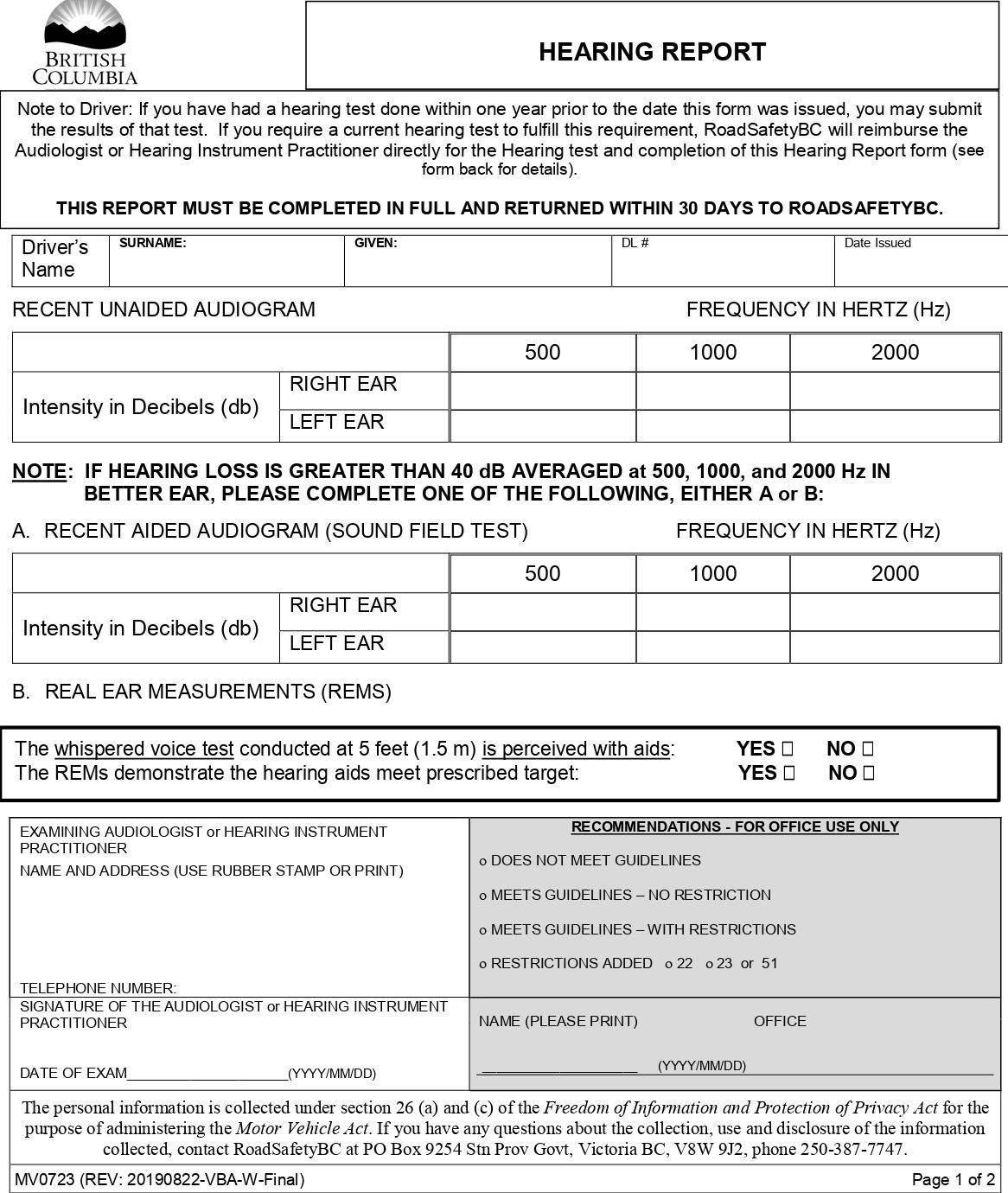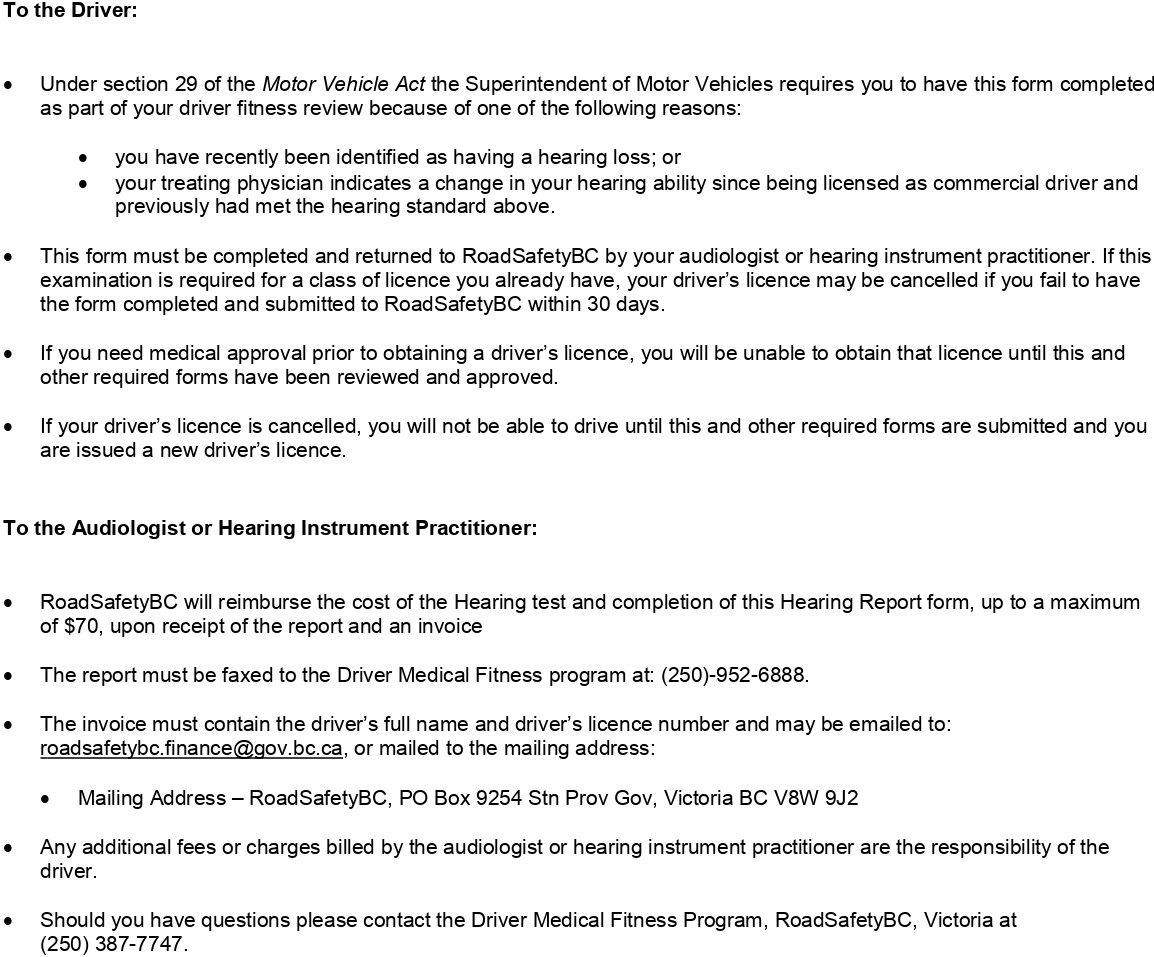9 - Hearing loss - CCMTA Medical Standards
Hearing loss and medical fitness to drive.
- 9.6.1 Hearing loss – Non-commercial drivers
- 9.6.2 Hearing loss – Commercial drivers
- 9.6.3 Hearing report
9.1 About hearing loss
Hearing loss is categorized as either conductive or sensorineural. Conductive hearing loss involves abnormalities in the external or middle ear, including the ear canal, eardrum or ossicles. A blockage or other structural problem interferes with how sound gets conducted through the ear, making sound levels seem lower. In many cases, conductive hearing loss can be corrected with medication or surgery.
Sensorineural hearing loss typically results from permanent damage to the inner ear (cochlea) or the auditory nerve. Typically, it is gradual, bilateral, and characterized by the loss of high-frequency hearing. Sensorineural hearing loss is permanent and often is helped with hearing aids. Profound deafness can be treated with cochlear implants.
Sensorineural hearing loss accounts for 90% of all hearing loss.
9.2 Prevalence
The 2003 Canadian Community Health Survey (CCHS) indicated that 3% of Canadians 12 years of age and older have some type of hearing difficulty. The prevalence of hearing loss increases with age. In the CCHS, 5% of 65 to 69 year-olds reported hearing problems, with the percentage increasing to 23% of those 80 and older. Hearing loss is more common in men than in women across every age group.
9.3 Hearing loss and adverse driving outcomes
The effects of hearing loss on the ability to safely operate a motor vehicle are not well established. Although the overall body of literature examining the relationship between hearing loss and driving is small, since the 1990’s there has been an increasing amount of research in this area. The results are equivocal. Some studies report an association between impairments in hearing and adverse driving outcomes while others have not found an association.
Although variability in methodology makes it difficult to draw conclusions across studies, results from studies indicate that, for the majority (70%) of study measures, no significant relationship was found between hearing loss and adverse driving outcomes (e.g. crashes, violations, convictions).
9.4 Effect on functional ability to drive
| Condition | Type of driving impairment and assessment approach | Primary functional ability affected | Assessment tools |
| Hearing loss | Persistent impairment: Functional assessment | Sensory - Hearing | Audiometric assessment |
The effect of hearing loss on functional ability to drive has not been established.
9.5 Compensation
Drivers with hearing loss may compensate for this impairment using auditory aids.
9.6 Guidelines for assessment
9.6.1 Hearing loss - Non-commercial drivers
| National Standard | All drivers eligible for a licence |
| BC Guidelines | RoadSafetyBC will not generally request further information |
| Conditions for maintaining licence | None |
| Reassessment | Routine |
| Information from health care providers | None |
| Rationale | There is insufficient evidence to support a minimum hearing requirement for non-commercial drivers |
9.6.2 Hearing loss - Commercial drivers
These guidelines apply to driver fitness determinations for commercial drivers who are required to conduct a pre-trip vehicle inspection under s.37.22 of the Motor Vehicle Act Regulation
| National Standard |
Eligible for class 2 and 4 driver licence, and classes 1, 3 and 5 when transporting dangerous goods, if either
|
| BC Guidelines |
RoadSafetyBC may find individuals fit to drive any type of commercial vehicles if
|
| Conditions for maintaining licence | No conditions are required |
| Restrictions |
|
| Reassessment |
RoadSafetyBC will re-assess in accordance with routine commercial re-assessment |
| Information from health care providers | Results of a recent auditory testing |
| Rationale |
The US FMCSA whisper test is described as:
|
9.6.3 Hearing report


